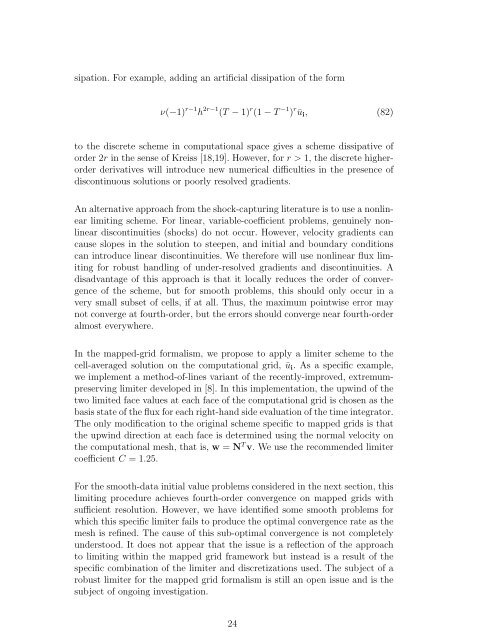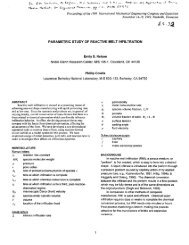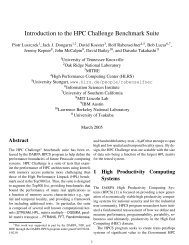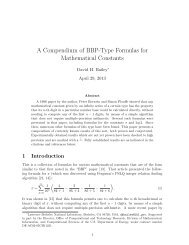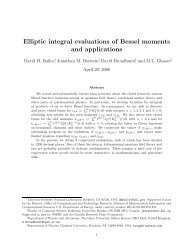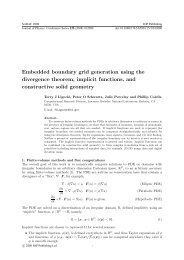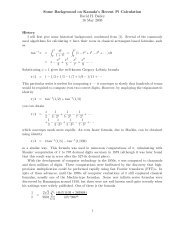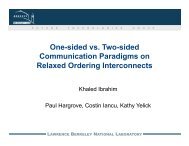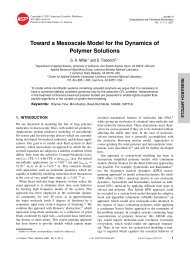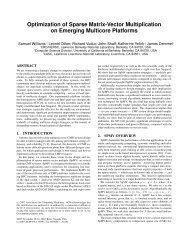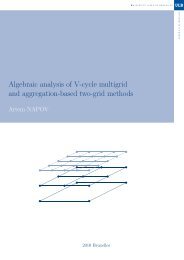High-Order, Finite-Volume Methods in Mapped Coordinates
High-Order, Finite-Volume Methods in Mapped Coordinates
High-Order, Finite-Volume Methods in Mapped Coordinates
You also want an ePaper? Increase the reach of your titles
YUMPU automatically turns print PDFs into web optimized ePapers that Google loves.
sipation. For example, add<strong>in</strong>g an artificial dissipation of the formν(−1) r−1 h 2r−1 (T − 1) r (1 − T −1 ) r ū i , (82)to the discrete scheme <strong>in</strong> computational space gives a scheme dissipative oforder 2r <strong>in</strong> the sense of Kreiss [18,19]. However, for r > 1, the discrete higherorderderivatives will <strong>in</strong>troduce new numerical difficulties <strong>in</strong> the presence ofdiscont<strong>in</strong>uous solutions or poorly resolved gradients.An alternative approach from the shock-captur<strong>in</strong>g literature is to use a nonl<strong>in</strong>earlimit<strong>in</strong>g scheme. For l<strong>in</strong>ear, variable-coefficient problems, genu<strong>in</strong>ely nonl<strong>in</strong>eardiscont<strong>in</strong>uities (shocks) do not occur. However, velocity gradients cancause slopes <strong>in</strong> the solution to steepen, and <strong>in</strong>itial and boundary conditionscan <strong>in</strong>troduce l<strong>in</strong>ear discont<strong>in</strong>uities. We therefore will use nonl<strong>in</strong>ear flux limit<strong>in</strong>gfor robust handl<strong>in</strong>g of under-resolved gradients and discont<strong>in</strong>uities. Adisadvantage of this approach is that it locally reduces the order of convergenceof the scheme, but for smooth problems, this should only occur <strong>in</strong> avery small subset of cells, if at all. Thus, the maximum po<strong>in</strong>twise error maynot converge at fourth-order, but the errors should converge near fourth-orderalmost everywhere.In the mapped-grid formalism, we propose to apply a limiter scheme to thecell-averaged solution on the computational grid, ū i . As a specific example,we implement a method-of-l<strong>in</strong>es variant of the recently-improved, extremumpreserv<strong>in</strong>glimiter developed <strong>in</strong> [8]. In this implementation, the upw<strong>in</strong>d of thetwo limited face values at each face of the computational grid is chosen as thebasis state of the flux for each right-hand side evaluation of the time <strong>in</strong>tegrator.The only modification to the orig<strong>in</strong>al scheme specific to mapped grids is thatthe upw<strong>in</strong>d direction at each face is determ<strong>in</strong>ed us<strong>in</strong>g the normal velocity onthe computational mesh, that is, w = N T v. We use the recommended limitercoefficient C = 1.25.For the smooth-data <strong>in</strong>itial value problems considered <strong>in</strong> the next section, thislimit<strong>in</strong>g procedure achieves fourth-order convergence on mapped grids withsufficient resolution. However, we have identified some smooth problems forwhich this specific limiter fails to produce the optimal convergence rate as themesh is ref<strong>in</strong>ed. The cause of this sub-optimal convergence is not completelyunderstood. It does not appear that the issue is a reflection of the approachto limit<strong>in</strong>g with<strong>in</strong> the mapped grid framework but <strong>in</strong>stead is a result of thespecific comb<strong>in</strong>ation of the limiter and discretizations used. The subject of arobust limiter for the mapped grid formalism is still an open issue and is thesubject of ongo<strong>in</strong>g <strong>in</strong>vestigation.24


